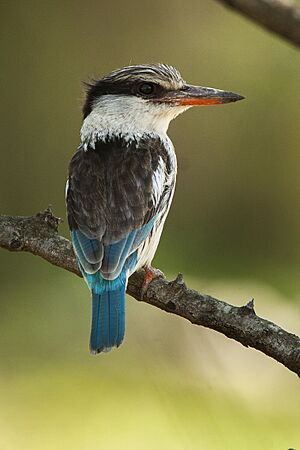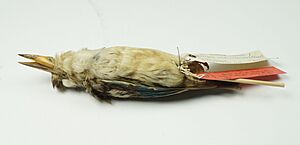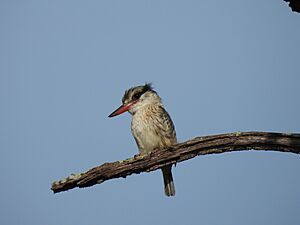Striped kingfisher facts for kids
Quick facts for kids Striped kingfisher |
|
|---|---|
 |
|
| Conservation status | |
| Scientific classification | |
| Subspecies | |
|

The striped kingfisher (Halcyon chelicuti) is a type of bird that belongs to the tree kingfisher family. It was first described in 1814 by Edward, Lord Stanley. He called it the "Chelicut kingfisher."
The name Halcyon comes from an old Greek legend. It was believed that a mythical bird, the halcyon, could calm the sea to lay its eggs on a floating nest. The name chelicuti comes from Chelicut in Ethiopia. This is where the first striped kingfisher specimen was found.
These birds are very protective of their homes. They will chase away other striped kingfishers. They also chase away other birds like shrikes, doves, and rollers. A kingfisher's territory can be as big as three hectares (about 7.4 acres). It might have 100 tall trees. The kingfisher watches its territory from a high treetop. It sings from before sunrise until after midday.
Contents
Where Do Striped Kingfishers Live?
This bird lives in many parts of Sub-Saharan Africa. You won't find it in very thick forests, especially near the Congo River. It also avoids the Horn of Africa, the Namib Desert, and South Africa.
Striped kingfishers prefer woodlands, thorny bushes, and open grasslands called savannas. They do not like areas where there is a lot of farming.
There are two main types, or subspecies, of the striped kingfisher:
- H. c. chelicuti: This type lives in most of the kingfisher's range.
- H. c. eremogiton: This type lives in the northern desert areas. These areas stretch from central Mali to the White Nile region in eastern Sudan. The two types can mix and have babies together in southern Mali.
What Does a Striped Kingfisher Look Like?
The common striped kingfisher (H. c. chelicuti) is about 16 to 18 centimeters (about 6.5 inches) long. This is measured from its beak to its tail.
When it is sitting, the bird looks mostly grayish-brown on its upper body. Its lower back, some wing feathers, and tail are a shiny blue color. This blue is much easier to see when the bird is flying. You can also see a white patch on its wings when it flies. The inside of its wings are white with a black edge. Male birds have an extra black bar on their wings.
The underside of the bird is off-white. It is a bit more yellowish-brown on the chest. Some birds in Kenya have brown streaks on their sides. Birds in southern Africa also have streaks on their chest. The top of the head is streaked dark brown. The background color is grayish-yellow in males and brownish in females. The sides of the head, throat, and a band around the back of the neck are off-white. A black line goes around the back of the neck and through the eyes. The beak is black on top and at the tip, but reddish-orange underneath.
Young kingfishers look like adults but are lighter in color. They have less blue on their wings and a darker head. Their chest feathers have dark tips. The lower part of their beak is a dull red.
The striped kingfisher has a special call. It sounds like a high-pitched, sharp "cheer-cherrrrrr" or a loud "KEW, kerrrrrrrrr." The "r" sounds are a repeated trill that gets lower in pitch. They often make this call in the evening, opening their wings as they do.
The northern type of kingfisher, H. c. eremogiton, has a grayish-brown head and back. Its underside has almost no streaks.
What Do Striped Kingfishers Eat?
Striped kingfishers mainly eat grasshoppers. They also eat other large insects. Sometimes, they will catch small lizards, snakes, and even tiny rodents.
They hunt from a high spot, usually about 3 meters (10 feet) off the ground. They swoop down to catch their prey. They can do this up to ten times a minute! They take their food back to their perch to eat it. If the prey is large, they hit it hard against the perch first.
When feeding their babies, they bring grasshoppers to the nest. They give the grasshoppers to the chicks head-first. This is similar to how water kingfishers give fish to their young.
Striped Kingfisher Reproduction
When a male and female striped kingfisher are ready to mate, they perform a display. They sit facing each other in a treetop with their tails pointing up. They open and close their wings while singing. Their "pee-hee" song quickly turns into short trills and pauses.
The female lays her eggs in an old hole made by a woodpecker or barbet. Both parents take turns sitting on the eggs during the day. Only the female sits on them at night. The male brings food to the female. He holds the food while she tears off pieces to eat.
Sometimes, other birds called Lesser honeyguides and greater honeyguides lay their eggs in the kingfisher's nest. This is called brood parasitism. It happens in about a quarter of striped kingfisher nests.
Striped kingfishers usually have one mate. However, sometimes a female might mate with more than one male. They usually have two sets of babies each year.
How Many Striped Kingfishers Are There?
The striped kingfisher lives across a very large area. This area is estimated to be about 13 million square kilometers (5 million square miles). Scientists believe there are many striped kingfishers in the world.
The number of these birds is not dropping quickly. Because of this, the species is listed as "Least Concern" by the IUCN Red List. This means they are not currently at risk of disappearing.
Images for kids





